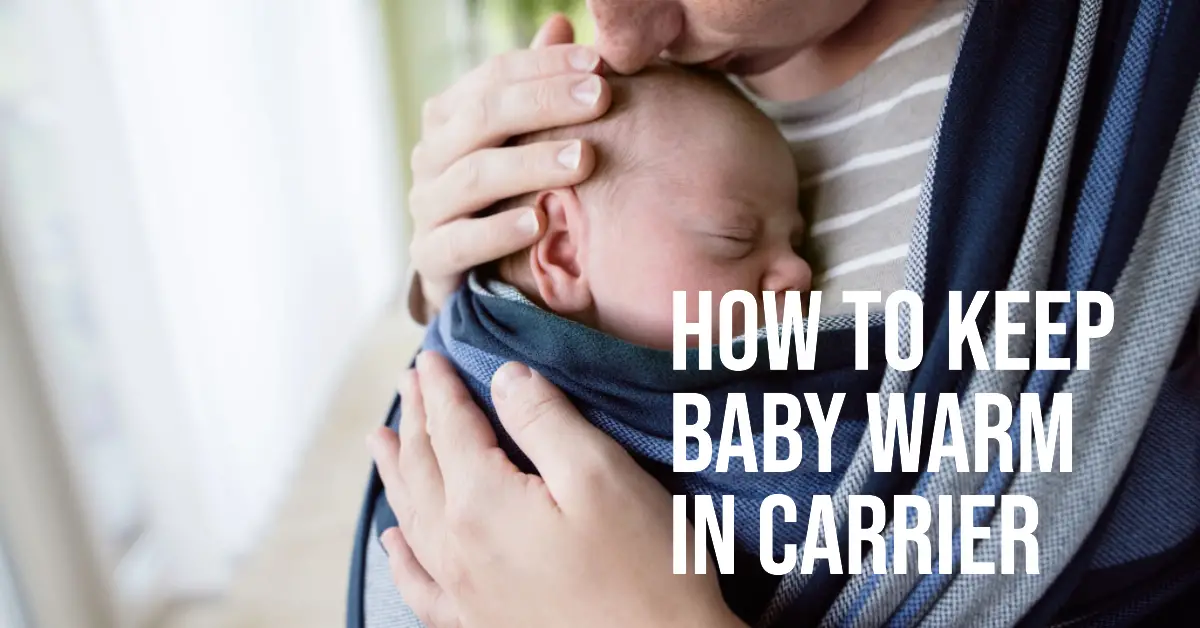Table of Contents
How to Keep Baby Warm in Carrier: A Comprehensive Guide for New Parents
As a new parent, you’ll quickly discover that your baby needs constant care and attention.
One of the most important aspects of this is keeping your little one warm and comfortable, especially when using a baby carrier.
In this article, we will discuss various tips and techniques on how to keep your baby warm in a carrier during those chilly days.
Choose the Right Carrier
First and foremost, it’s crucial to choose the right carrier for your needs and the specific weather conditions.
There are several types of carriers available on the market, designed for various climates and purposes.
When selecting a carrier, consider factors such as the carrier’s fabric, its adjustability, and whether it has any additional features for weather protection.
Keep in mind that best baby carriers for petite moms and best baby carriers for back pain may differ, so choose what works best for you.
Layer Up
Layering is key when it comes to keeping your baby warm.
Dress your baby in layers to help regulate their temperature, and adjust accordingly when you move from outdoors to indoors.
Start with a comfortable onesie or bodysuit made of high-quality material that will wick moisture away from the skin.
Learning which materials are best for baby clothing can help you make an informed decision.
Next, add a warm layer such as a fleece or wool sweater.
Keep in mind that you should follow tips for dressing your baby in cold weather.
If it’s particularly cold outside, you can also use a baby sleeping bag designed for cold weather.
Avoid bundling them too tight, but make sure they remain secure in the carrier.
Protect the Extremities
Babies lose heat faster through their extremities, so it is essential to protect their hands, feet, and head.
Invest in a warm hat to cover the head and ears, and use mittens to keep their hands warm.
Make sure to choose booties that offer proper insulation and coverage without restricting movement.
To ensure a comfortable and safe fit, choose footwear and accessories that are specifically designed to be used with baby carriers.
Carrier Accessories for Extra Warmth
There are several carrier accessories available that can provide additional warmth and protection for your baby.
Consider using a weather cover designed for your specific carrier model, which can offer protection from wind, rain, and snow.
Many weather covers are adjustable and can be easily attached or removed, depending on the conditions.
Additionally, you can use a baby carrier blanket that can be securely wrapped around your baby and carrier, providing an extra layer of insulation.
Some blankets come with elastic or straps to help it stay in place.
Moreover, you can use cloth diapering with wool to keep your baby dry for up to 12 hours, ensuring added warmth and comfort.
Keep an Eye on the Baby’s Temperature
While it’s crucial to keep your baby warm, it’s equally essential to avoid overheating.
Continuously monitor your baby’s temperature, especially when you’re moving between different environments.
Signs of overheating include sweating, flushed cheeks, and rapid breathing.
Remove a layer of clothing or loosen the carrier if you notice your baby feeling too warm.
If you’re unsure about baby’s temperature, check their neck or back, as these areas provide a more accurate indication than the hands or feet.
Make Adjustments for Comfort
With changing weather conditions, it’s essential to be ready to make adjustments and ensure your baby remains comfortable.
As you make your baby comfortable in a carrier, it may involve tweaking the carrier’s fit or adding or removing layers of clothing as needed.
It is also crucial to choose the right baby clothes and ensure that they are well-fitting and functional.
Focus on keeping baby warm while avoiding unnecessary bulk that could interfere with the carrier’s function or make your little one uncomfortable.
Carrier Safety Tips for Cold Weather
Apart from keeping your baby warm and cozy, it’s crucial to ensure their safety when using a baby carrier during cold weather.
Here are some essential safety guidelines to follow to provide a secure and pleasant experience for your baby.
Adjust the Carrier Properly
Making sure your baby carrier is adjusted correctly is vital for safety and comfort.
An improperly fitted carrier can lead to safety concerns and make it difficult to monitor your baby’s well-being.
Ensure that the straps and buckles are securely fastened and that the carrier is snug against your body, but not too tight that it restricts your baby’s breathing.
Adjust the carrier according to your baby’s size and growth, as well as any added clothing layers.
Maintain Clear Airways
Regardless of the weather conditions, it is essential to ensure your baby’s airways are always clear when in the carrier.
Place your baby’s face close to you, with their chin off their chest, to maintain an open airway.
During cold weather, avoid covering your baby’s face with hoods or scarves, as this can lead to overheating and obstruct their breathing.
Instead, opt for a warm hat that covers their head without blocking their airways.
Use the Carrier in an Age-Appropriate Manner
It’s important to use a baby carrier that’s appropriate for your child’s age, weight, and development.
Some carriers are designed for newborns, while others cater to older infants and toddlers.
Ensure you follow the manufacturer’s guidelines regarding the suggested age range and weight capacity for your chosen carrier.
Familiarize yourself with the different carrying positions suitable for different developmental stages.
Be Mindful of Your Movements
While carrying your baby in cold weather, it’s crucial to be cautious of your movements and surroundings.
Slipping on ice or uneven terrain poses a risk to both you and your baby.
Wear appropriate footwear with good traction and stay vigilant of your environment.
Avoid sudden movements and pay close attention to your balance, ensuring that your body movements are slow and controlled.
Preparing for Outdoor Adventures with Your Baby
Once you’ve mastered the art of keeping your baby warm and safe in their carrier during cold weather, you can confidently embark on outdoor adventures together.
Plan accordingly and ensure you have all the necessary supplies for your outing:
By being prepared and ensuring your baby is warm, cozy, and safe in their carrier, you can fully embrace the joys of exploring the outdoors together, even during the chilliest days.
Frequently Asked Questions
Q: Is it safe to cover my baby’s face with a blanket or hood while they’re in the carrier?
A: No, it’s essential to keep your baby’s face uncovered and ensure clear airways at all times. Use a warm hat instead, which covers their head without obstructing their breathing.
Q: How can I monitor my baby’s temperature while they’re in the carrier?
A: Regularly check the back of their neck or the area between their shoulder blades, as these spots provide a more accurate indication of their body temperature than the hands or feet.
Q: What accessories can I use with my baby carrier to keep them warm during cold weather?
A: Consider using a weather cover, baby carrier blanket, or additional layers of clothing to provide extra warmth for your baby.
In conclusion, keeping your baby warm in a carrier is an essential part of ensuring their comfort and safety during cold weather.
By choosing the right carrier, layering appropriately, protecting extremities, and using carrier accessories, you can enjoy outdoor adventures with your baby while keeping them happily snug.


